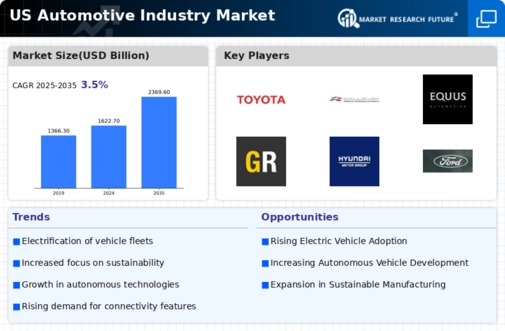Us Automotive Industry Size
US Automotive Industry Market Growth Projections and Opportunities
The US automotive industry is deeply influenced by a myriad of market factors that shape its dynamics, trends, and competitiveness. One of the most prominent factors is consumer demand, which is driven by economic conditions, changing preferences, and technological advancements. Economic fluctuations, such as recessions or periods of growth, directly impact consumers' purchasing power and willingness to buy new vehicles. Additionally, shifts in consumer preferences towards fuel-efficient or electric vehicles, as well as trends in vehicle design and features, heavily influence the market landscape.
Government regulations and policies also play a crucial role in shaping the automotive market in the US. Stringent emission standards, safety regulations, and fuel efficiency requirements set by federal and state governments influence the types of vehicles manufactured and sold in the country. For instance, the push towards electric vehicles has been accelerated by government incentives, tax credits, and mandates aimed at reducing greenhouse gas emissions and promoting sustainability.
Technological innovation is another significant market factor driving change in the US automotive industry. Advancements in autonomous driving technology, connectivity features, and electric powertrains are reshaping the way vehicles are designed, manufactured, and used. Companies that invest in research and development to stay at the forefront of innovation often gain a competitive edge in the market, while those slow to adapt may struggle to keep pace with evolving consumer expectations.
Globalization and international trade also impact the US automotive market. The industry is interconnected with suppliers, manufacturers, and consumers worldwide, making it susceptible to changes in global trade policies, tariffs, and geopolitical tensions. Shifts in supply chains, trade agreements, and foreign exchange rates can affect the cost of production and ultimately the prices consumers pay for vehicles.
Market competition among automakers and suppliers is intense, driving companies to constantly innovate and differentiate their products and services. Brand reputation, product quality, pricing strategies, and marketing efforts all play a role in determining market share and profitability. Companies that effectively anticipate and respond to market trends, consumer preferences, and competitive pressures are more likely to succeed in this dynamic industry.
Environmental sustainability and corporate social responsibility have become increasingly important considerations for consumers and stakeholders in the automotive industry. Companies are under pressure to reduce their carbon footprint, minimize waste, and adopt sustainable practices throughout the value chain. Investments in eco-friendly manufacturing processes, renewable energy sources, and recyclable materials not only contribute to environmental conservation but also enhance brand image and customer loyalty.
Lastly, demographic trends such as population growth, urbanization, and generational shifts impact the automotive market. Millennials and Gen Z consumers, for example, often have different preferences and priorities compared to older generations, influencing the types of vehicles they purchase and how they use transportation services. Additionally, changes in lifestyle trends, such as the rise of ride-sharing and mobility-as-a-service platforms, are reshaping traditional notions of car ownership and usage patterns.
In conclusion, the US automotive industry is influenced by a complex interplay of market factors ranging from consumer demand and government regulations to technological innovation and global trade dynamics. Companies operating in this competitive landscape must continuously adapt to evolving trends and consumer preferences while navigating regulatory challenges and competitive pressures to thrive in the market.







Leave a Comment